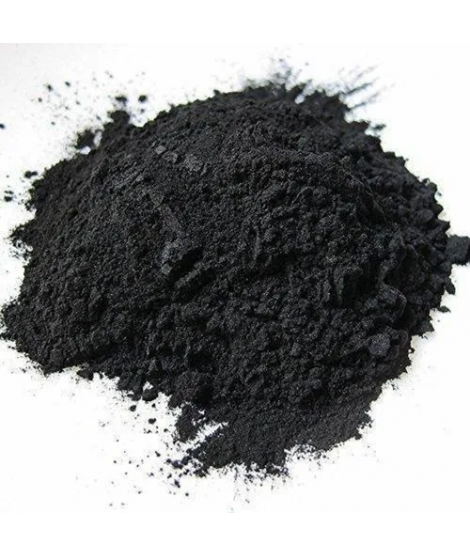ACTIVATED CARBON (pharma grade), kg
4.39 €
Activated charcoal, CAS 7440-44-0, activated carbon, food-grade charcoal, Activated Charcoal Norit, Norit SX ultra, INCI CHARCOAL POWDER, charcoal for alcohol purification
Parameter | Attribute |
Coal | Activated Charcoal, Activated coal, Active Charcoal, Activated Charcoal Norit, Norit SX ultra, CHARCOAL POWDER |
Formula | C |
Structure |  |
IUPAC | Carbon |
INCI | CHARCOAL POWDER |
CAS | 7440-44-0 |
Molar mass | 12,01 g/mol |
Density | 0,32g/cm3 (bulk) |
Solubility | Insoluble in water, makes suspension |
Activated carbon is used for methane and hydrogen storage, air purification, capacitive deionisation, supercapacitive oscillating adsorption, solvent recovery, caffeine removal, gold purification, metal extraction, water purification, medical applications, wastewater treatment, air filters in respirators, filters in compressed air, tooth whitening, production of hydrogen chloride, food electronics, and a wide range of applications. Compliant with the US Food Chemicals Code (3rd edition). Norit SX ULTRA is an acid-washed, vapour-activated carbon with excellent adsorption for colorless liquids or white crystals and excellent filtration properties.
Main characteristics:
Iodine number | 1100 |
Number of molasses EUR | 160 |
Adsorption of methylene blue | 23g/100g |
Total surface area (B.E.T.) | 1200m2/g |
Apparent density (compressed) | 320kg/m3 |
Particle size D10 | 5 μm |
Particle size D50 | 25 μm |
Particle size D90 | 100 μm |
Ash content | 5% |
Chlorides (acid extraction) | 0.1% |
pH | neutral |
Filtration time | 18 min |
In industry, one of the main applications is the use of activated carbon in metal finishing to purify electroplating solutions. For example, it is the main cleaning method for removing organic impurities from bright nickel plating solutions. Various organic chemicals are added to plating solutions to improve their precipitation properties and to improve properties such as brightness, smoothness, plasticity, etc. Organic additives create unwanted degradation products in the solution due to the direct current passage and electrolytic reactions of anodic oxidation and cathodic reduction. Excessive accumulation of these can adversely affect the quality of the coating and the physical properties of the deposited metal. Treatment with activated carbon removes such impurities and restores the deposition efficiency to the desired level.
In medicine, activated carbon is used to treat poisonings and overdoses after being drunk. Activated charcoal tablets or capsules are used in many countries as an over-the-counter remedy for diarrhoea, indigestion and flatulence. However, activated charcoal has no effect on intestinal gas and diarrhoea and is usually medically ineffective in the case of poisoning by ingestion of corrosive substances, boric acid, petroleum products, and is particularly ineffective in the case of poisoning by strong acids or bases, cyanide, iron, lithium, arsenic, methanol, ethanol or ethylene glycol. Activated carbon will not prevent the absorption of these chemicals into the human body.
In analytical chemistry, activated carbon at 50 % w/w in combination with celite is used as a stationary phase for the low-pressure chromatographic separation of carbohydrates (mono-, di-, tri-saccharides), using ethanol solutions (5-50 %) as the mobile phase in analytical or preparatory tests. Activated carbon is useful in the isolation of direct oral anticoagulants (DOACs) such as dabigatran, apixaban, rivaroxaban and edoxaban from plasma samples. For this purpose, it was made into 'minitabletes', each containing 5 mg of activated carbon, to process 1 ml of DOAC samples. Since this activated carbon does not affect blood clotting factors, heparin or most other anticoagulants, it allows the plasma sample to be analysed for abnormalities otherwise affected by DOACs.
In the environmental field, activated carbon is mainly used in water filtration systems. Carbon adsorption is tailored to remove pollutants from air or water streams, both outdoors and in industrial processes such as:
- Cleaning spills from industrial plants
- Treatment of groundwater
- Drinking water filtration
- Air purification
- Capture of volatile organic compounds during painting, dry cleaning, petrol dispensing and other processes
- Recovery of volatile organic compounds (solvent recovery systems, SRU) from flexible packaging, converting, coating and other processes.
Activated carbon filtration is an effective method of water purification due to its multi-functionality. Depending on the pollutants to be collected, specific activated carbon filtration methods and equipment are selected. Activated carbon is also used to measure radon concentrations in air. Portable activated carbon water purification filters are used for camping and outdoor survival.
In agriculture, activated carbon (charcoal) is a permitted substance used by organic farmers in both livestock and wine production. In livestock farming it is used as a pesticide, feed additive, processing aid, non-agricultural ingredient and disinfectant. In organic wine production, activated carbon is allowed to be used as a processing agent to adsorb brown pigments from white grape concentrates. It is sometimes used as a biochar.
Purification of distilled alcoholic beverages with activated carbon filters (AC filters) can be used to filter vodka and whisky from organic impurities that may affect colour, taste and odour. Passing organically impure vodka through an activated carbon filter at the appropriate flow rate results in a vodka with identical alcohol content and a significantly increased organic purity in terms of aroma and taste. Up to 20 litres of alcohol can be purified with 400ml of activated carbon
Fuel storage conducts research to test the ability of various activated carbons to store natural gas and hydrogen gas. The porous material acts as a sponge for different types of gas. The gases are attracted to the carbon material through Van der Waals forces. Some carbon compounds have been able to achieve binding energies of 5-10 kJ per mole. The gas can then be desorbed when exposed to higher temperatures and burned. Gas storage in activated carbons is an attractive way of storing gases, as the gas can be stored in a low pressure, low mass and low volume environment, which would be much more feasible than in pressure tanks installed in large vehicles.
In gas cleaning, activated carbon filters are commonly used to clean compressed air and gases to remove oil vapour, odour and other hydrocarbons from the air. The most common filtration principles are 1- or 2-stage filtration, where activated carbon is embedded in the filtration medium. Activated carbon filters are used to trap radioactive gases in the air extracted from the turbine condenser of a nuclear boiling water reactor. Large layers of carbon adsorb these gases and trap them until they decompose rapidly into non-radioactive solids. The solid particles are trapped in the carbon particles and the filtered air passes through.
In chemical purification, activated carbon is mainly used on a laboratory scale to purify solutions of organic molecules containing unwanted coloured organic impurities. Filtration through activated carbon is used for the same purpose in large-scale small-scale chemical and pharmaceutical processes. The carbon is mixed with a solution and then filtered or immobilised in a filter.
In mercury remediation, activated carbon is widely used to trap mercury emissions from coal-fired power plants, medical waste incinerators and natural gas wellheads. If the activated carbon contains less than 260 ppm of mercury, United States federal regulations allow it to be stabilised (e.g., embedded in concrete) so that it can be disposed of in a landfill.
In the food industry, activated charcoal is used as an additive to give a "slightly smoky" flavour and dark colour to products including hot dogs, ice cream, pizza bases, and bagels. People taking medicines, including contraceptive pills and antidepressants, are advised to avoid innovative foods or drinks that use activated charcoal dyes, as this may render the medicines ineffective.
In cosmetics, the adsorption properties of activated carbon have made it a popular ingredient in many skincare products. Products such as activated carbon soaps and activated carbon face masks and scrubs combine the adsorption properties of carbon with the cleansing properties of soap. The main INCI properties are:
- Abrasive: removes substances from the surface of the body, helps clean teeth and improves shine.
- Adsorbent: Absorbs water (or oil) in dissolved or fine form
- Opacity: reduces the transparency or translucency of cosmetics.
In painting, charcoal pigments are obtained by burning wood, usually vine, beech, maple, lime. Their properties are very similar to grape black. Particularly widely used in wall painting and mouldings. Mixable with all pigments. They are used to make charcoal sticks for drawing. Activated charcoal particles are very fine and the smaller they are, the more intense the colour of the pigments. This very fine pigment is able to penetrate from the lower layers to the upper layers in multilayer oil paintings, which is why Grape Black or Peach Black are more commonly used in oil paintings. Soot is needed for watercolours, typographic inks and inks. They are miscible with all pigments, resistant to acids, alkalis and high temperatures.
Important: Add the item to your basket, fill in the recipient's details and confirm your order. Thank you!
To save your precious time, we will deliver your order to your address at a time convenient for You!
*- The pictures of the goods may not correspond to the actual appearance, color, assembly or shape of the goods and their packaging. The information in the product description is of a general nature and may not correspond to the information on the packaging of the product and may not be the exact use of the product. The information given on the stocks and prices of goods may, in certain cases, differ from the actual prices and stocks of goods
Signal word: Not applicable |
Hazard icons: Not applicable |
Danger phrases: Not applicable |
Precautionary statements: Not applicable |
Related products
(8 other products in the same category)










